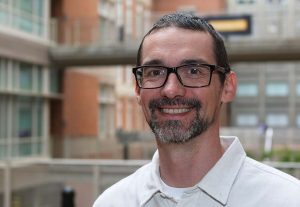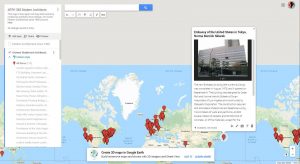September, 08, 2020
By The College of Arts and Sciences
When classes once again shifted to remote delivery in fall 2020, faculty across the College of Arts & Sciences, with the help of technology and instructional learning experts, say they were better prepared for it — having worked diligently since last spring to reimagine their fall courses amid the COVID-19 pandemic.
Brian Hogan, teaching professor in the department of chemistry, says a successful remote course is highly structured, with pre- and post-class assignments in addition to class time.
That’s something Hogan found takes significant time to develop. But his experience last spring, when all classes had to move abruptly to remote instruction laid the groundwork for teaching “Introduction to Biochemistry” in both summer sessions.

Those experiences, plus brainstorming with colleagues and the summer students’ largely positive responses, helped hone the format he is using this semester. The 250 students in the course this fall are interacting with him remotely through Sakai, the educational software platform used by UNC.
“I’ve structured my classes so students know exactly what they’re going to get and what they need to do every day,” said Hogan, who is also chemistry’s vice chair of education.
The students’ online checklist for each class period includes watching a pre-recorded 75-minute interactive lecture, with Hogan’s notes and PowerPoint slides provided. About every five or six minutes throughout the lecture, Hogan tells the students to pause the recording and work out an assigned practice problem before they hit “play” again to solve the problem in a pre-recorded segment with him.
He can tell who has accessed the site, how they answered the questions and problems, and how they scored, and he provides feedback. Outside of class, the students can schedule personal time with Hogan or his teaching assistants via Zoom.
“Now that I know I’m giving the students a good learning experience, I can use these online teaching tools every semester in perpetuity,” he said.
Creating meaningful remote global experiences
Ways to provide a global experience are also changing during the pandemic. International travel restrictions mean that connecting online has become even more crucial.
Michele Rivkin-Fish saw that as an opportunity to introduce her anthropology students to Russian culture and history on a personal level. Although she has taught “Health and Gender After Socialism” many times, this is the first time her students will be able to talk directly with their Russian peers via Zoom. The Center for Slavic, Eurasian and East European Studies is supporting her course connections with Russian faculty and students.
Four joint discussion sessions with her Russian faculty counterparts will focus on daily life during COVID-19, transitions to adulthood, family planning and adult children’s interactions with their parents. The 31 upper-class UNC students will then be placed in small groups with students from the Higher School of Economics in Moscow for Zoom breakout sessions to delve into their distinct experiences.
For example, each group will discuss what makes them feel that they are now adults, explained Rivkin-Fish, associate professor of anthropology. Her students will keep journal entries about these conversations as the basis for a final paper on a topic they choose.
The small-group conversations not only allow the students to get to know one another, they can be set up at mutually convenient times, which should help overcome the challenges of an eight-hour time difference.
Her goal in teaching about Russia is to go beyond the headlines. “As a cultural anthropologist, I try to help people see that there’s a rich culture and history of thoughtful, complicated people who can’t be equated with their government,” Rivkin-Fish said.
“And it is important to learn how to talk with people from other cultures when we find that we don’t understand them or they don’t appreciate us. These are both the challenges and the rewards of global connections.”
Teaching art with creative learning options
JJ Bauer’s “Modern Architecture” course is a combination of lecture and small-group discussion, all through Zoom. The students will work in groups throughout the semester to focus on a particular aspect of a work of modern architecture and report back to the class. They also will work together to expand the extensive online Google map that highlights works by architects since 1900, this semester adding a layer on endangered or lost modernist buildings.

Their final paper will examine a particular work, ultimately analyzing its relation to other works by the same architect, works of the same period and the relationship to surrounding buildings. Or students can choose instead to focus their final paper on the way modern architects respond to pandemics, either historically or by examining what current architects are proposing in light of the coronavirus.
“People don’t realize that diseases have played a role in architecture itself by shifting thinking about the design of buildings, cities and spaces,” said Bauer, teaching assistant professor of art and art history and visual resources curator. For example, urban public parks like New York City’s Central Park were created in part to increase access to fresh air in cities crowded with tenements and sooty from industrial pollution, while the clean lines of 20th century design were partially a response to the 1918 flu, the tuberculosis epidemic and, later, the polio outbreak.
“One of the things I try to make clear is that architecture is an art form, but it’s also unique because it has an effect on everyone’s life,” Bauer said.
Exercising for physical and mental health
Lifetime Fitness, or LFIT classes, are designed to help students engage in healthy physical activity; all students are required to take one to graduate. Through physical activity and online instruction, students learn the importance of developing and maintaining a healthy lifestyle, something that’s incredibly timely during a pandemic.
Because of the experience with the shift to all online learning last semester, the five labs in which students track their overall health and fitness during the semester were easy to transition to virtual this fall, said Becca Battaglini, LFIT director and teaching assistant professor in the department of exercise and sport science.
But the physical activities, which range from yoga to weight training to jogging, have required some creativity. Just as in the spring, the 45 teaching assistants are instructing the students through Zoom – sometimes working out together, other times preparing lessons that the students do on their own. In those cases, the students submit commentary about what they did, along with a photo of themselves working out or a screen shot of their exercise tracking app.
The various adaptations faculty and students have had to make for the fall are actually life lessons, Battaglini said.
“You have to be able to roll with the punches and learn to adapt quickly,” she explained. “This might not be exactly what we had originally planned, but we are doing everything we can to help our students succeed.”
Technology staff play critical role in teaching success
The College’s Office of Arts & Sciences Information Services, or OASIS, has worked with faculty and other technical staff since the spring and throughout the summer to help with creative technology solutions.
“From discussions that took place all summer with each of our departments about their general instructional plans for the fall, we’ve been able to surface opportunities to help with specific instructional needs,” said Andy Lang, associate dean of IT and data analytics.
OASIS, along with the Center for Faculty Excellence, is part of a key network of support behind Keep Teaching, a website that provides strategies and tools for remote instruction.
Examples of fall innovations include:
- The English and comparative literature department is piloting Google’s G Suite for Education as part of its innovation in teaching first-year writing courses. The suite includes tools for organizing and managing class assignments and collaboration, including online forums and small group discussions, as well as providing a host of shareable Google-based documents and forms.
- Students in the departments of city and regional planning and geography are accessing their computer labs remotely to use ArcGIS, a popular web-mapping platform for data analysis and visualizations. OASIS devised a way to make this possible and then partnered with ITS to make the lab computers remotely accessible so that students can access this software while the instructor leads the class via Zoom. As an added benefit, and using Zoom’s screen-sharing capability, this configuration enables students who are using these lab computers to share their work with the rest of the class in a way that is perhaps easier than if it were done in person. This solution was piloted in the spring and is being used more widely this fall.
- OASIS is partnering with the Study Abroad Office for students to have virtual global experiences through Connecting Carolina Classrooms with the World, which was launched in May.
- Students in the Carolina Away program can examine the pandemic from different perspectives in the dozen or so online courses that make up “COVID Investigations.”
Although the abrupt shift again this fall is sure to provide new challenges, departments and faculty members are much better prepared than they were last spring, Lang said. The summer provided more lead time to adapt courses, and, moreover, faculty who taught during the spring or over the summer now have much more experience with remote instruction.
“I think the greatest story in this is how the University community has really come together to address these issues,” Lang said. “In the spring, people saw what needed to get done, they rolled up their sleeves and got to work. We all knew what we were good at and how to partner with one another. That was a key ingredient in how classes were able to pivot in the spring, and it’s something we’ve carried forward to make fall instruction possible.”
By Patty Courtright, College of Arts & Sciences

